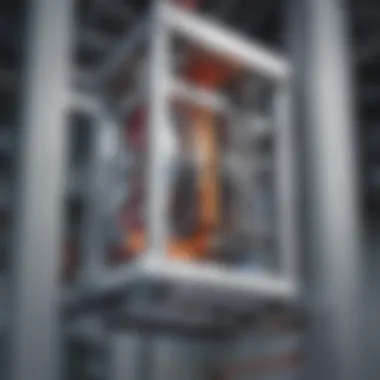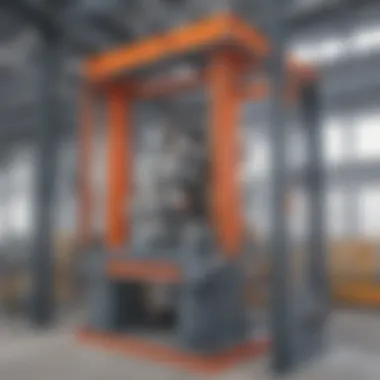Unveiling the Intricate Mechanics Behind Building Lift Machines


Science Fun Facts
Building lift machines have been a cornerstone of modern construction, revolutionizing the way we navigate tall structures. The engineering marvel behind these systems intricately combines various disciplines, from mechanical and electrical engineering to architecture. Did you know that the concept of elevators dates back to the ancient Greeks and Romans, who used rudimentary lift systems powered by human or animal labor?
Understanding the evolution of lift machines provides a unique glimpse into human ingenuity, showcasing how innovations throughout history have shaped our contemporary infrastructure. From hand-cranked devices to sophisticated computer-controlled systems, the progression of lift technology highlights our continual quest for efficiency and safety in vertical transportation.
Discover the Wonders of Science
Embark on a journey through the inner workings of building lift machines, where science and engineering converge to create seamless vertical transport. Explore the fundamental principles of pulleys, counterweights, and hydraulics that underpin the operation of these elevators. Engaging animations and interactive tools can simulate the intricate mechanisms at play, offering a hands-on learning experience for aspiring engineers and curious minds.
Uncover the real-world applications of scientific concepts in lift design, from Newton's laws of motion influencing elevator acceleration to material science dictating the construction of sturdy lift shafts. Witness the intersection of physics and architecture as these disciplines harmonize to ensure the safety and efficiency of vertical transportation systems.
Science Experiment Showcase
Get hands-on with lift machine experiments to demystify the science behind these complex systems. Create your miniature pulley system using household materials, exploring the mechanical advantage of different configurations. Follow step-by-step instructions to construct a simple lift model and understand the role of counterweights in balancing elevator cars.
Ensure safety by practicing precautionary measures when conducting lift experiments, emphasizing the importance of supervision and proper handling of materials. By immersing yourself in these engaging activities, you can deepen your understanding of lift machine dynamics and appreciate the scientific principles at work.
Introduction
Defining Lift Machines
Understanding the concept of lift machines
Delving into the concept of lift machines unveils the core principles that drive vertical transportation systems within buildings. The essence of these machines lies in their ability to move occupants and cargo efficiently between different floors, enhancing accessibility within architectural marvels. Understanding the intricacies of lift machine dynamics provides engineers and architects with a foundational knowledge base essential for creating functional and safe lift systems. Despite its complexity, comprehending the concept of lift machines stands as a cornerstone in the construction industry, revolutionizing vertical mobility.
Key components of lift systems
The key components constituting lift systems play a pivotal role in ensuring the reliable and smooth operation of these vertical transportation marvels. From the sturdy steel ropes that support the lift carriages to the intricate control panels responsible for managing movement, each component contributes to the overall functionality and safety of lift machines. Recognizing the significance of these components empowers industry professionals to make informed decisions regarding design and maintenance, elevating the standard of lift system performance within buildings.
Significance of Efficient Lift Machines


Enhancing building functionality
Efficient lift machines are instrumental in optimizing building functionality by streamlining vertical movement mechanisms. These devices eliminate the constraints imposed by traditional staircases, providing a faster and more convenient mode of transportation between floors. The seamless integration of efficient lift systems enhances the overall operational efficiency of buildings, contributing to increased productivity and space utilization.
Improving user experience
A paramount aspect of efficient lift machines lies in their ability to enhance the overall user experience within buildings. By reducing waiting times, optimizing cabin space, and ensuring smooth transitions between floors, these systems prioritize user comfort and satisfaction. Investing in user-centric lift solutions not only enhances the convenience of vertical transportation but also reflects a commitment to modernity and architectural innovation.
Objective of the Article
To explore the intricate details of lift machines
The primary objective of this article is to delve deep into the intricate details surrounding the design, construction, and operation of lift machines. By dissecting each element that contributes to the functionality and safety of these essential devices, we aim to provide engineers, architects, and construction professionals with a comprehensive understanding of the intricacies involved in lift system management. From discussing structural considerations to exploring maintenance protocols, this article serves as a guiding beacon in navigating the complexities of building lift machines.
Designing Lift Machines
Designing Lift Machines is a critical aspect of constructing efficient and safe lift systems. The structural integrity and functional performance of lift machines heavily depend on the design choices made during this phase. Engineers and architects must meticulously consider various elements such as load-bearing capacity and material selection to ensure the lift operates seamlessly and meets all safety standards.
Structural Considerations
Load-bearing capacity
Load-bearing capacity is a fundamental aspect of lift machine design as it determines the weight the lift can safely support. Enhancing the load-bearing capacity ensures the lift can accommodate larger loads, improving efficiency and safety. By utilizing robust materials and strategic engineering, the load-bearing capacity can be optimized to withstand substantial weights, enhancing the overall reliability of the lift system. Despite its importance, overestimating load-bearing capacity can lead to unnecessary costs and space limitations, highlighting the need for precise calculations and thorough assessments before implementation.
Material selection
Material selection plays a crucial role in defining the durability and performance of lift systems. Choosing the right materials for various components like cables, carriages, and support structures is essential to ensure longevity and smooth operation. High-quality materials that offer strength, corrosion resistance, and longevity are preferred for lift machine construction. However, the drawback of premium materials may include higher costs and intricate maintenance requirements. Engineers must strike a balance between durability and cost-effectiveness when selecting materials to achieve an optimal lift design that meets safety standards without exceeding budget constraints.
Safety Measures
Emergency braking systems


Emergency braking systems are vital safety features in lift machines, activated in case of emergencies or malfunction. These systems provide a swift response to abruptly stop the lift and protect passengers from potential hazards. The key characteristic of emergency braking systems is their quick and reliable engagement, ensuring immediate safety during critical situations. While these systems significantly enhance passenger protection, their installation and maintenance must adhere to strict regulations to guarantee optimal functionality at all times.
Overload protection
Overload protection mechanisms safeguard lift systems from excessive weight, preventing equipment damage and ensuring passenger safety. The key characteristic of overload protection is its ability to detect abnormal loads and initiate safety protocols to prevent accidents. By incorporating sensors and control systems, lift machines can automatically respond to overloading scenarios, mitigating risks effectively. However, the complexity of overload protection systems may increase installation and maintenance costs, necessitating comprehensive training for maintenance personnel to ensure accurate calibration and troubleshooting.
Efficiency in Design
Optimizing space utilization
Optimizing space utilization in lift design is crucial for maximizing building functionality and passenger convenience. By strategically arranging components and streamlining design elements, engineers can create compact lift solutions that efficiently utilize available space. The key characteristic of optimizing space utilization is the seamless integration of components to minimize footprint while maintaining operational efficiency. While compact designs enhance building aesthetics and accessibility, potential challenges may arise in retrofitting existing structures to accommodate space-optimized lifts, requiring innovative engineering solutions and meticulous planning.
Energy-efficient solutions
Energy-efficient solutions in lift design focus on minimizing power consumption and reducing environmental impact. By incorporating technologies such as regenerative drives and LED lighting, lift systems can operate with increased energy efficiency, benefiting both building owners and the environment. The key characteristic of energy-efficient solutions is their ability to reduce operational costs and carbon footprint through sustainable practices. However, the initial investment in energy-efficient technologies may pose financial challenges for some projects, necessitating a long-term cost-benefit analysis to determine the feasibility of integration. Engineers must balance the environmental benefits with economic considerations to implement energy-efficient solutions effectively.
Construction Process
In the vast landscape of constructing lift machines, the Construction Process stands as a pivotal stage, laying the foundation for seamless functionality and structural integrity. This section delves into the intricate procedures and methodologies involved in bringing lift machines to life within the architecture of a building. Each step in the Construction Process is meticulously planned and executed to ensure the highest standards of safety, efficiency, and compliance.
Installation
Installation plays a critical role in the Construction Process of lift machines, encompassing the meticulous assembly of various components that form the backbone of the system. The Installation phase requires a keen eye for detail and precision to guarantee that every part is seamlessly integrated to support the smooth operation of the lift.
Assembling components
Assembling components is a meticulous process where each piece, from the smallest bolt to the most complex motor, is carefully connected to create a unified system. The efficiency of the Assembling components directly impacts the overall performance and durability of the lift machine. By focusing on precise assembly, engineers can enhance the reliability and functionality of the entire system.
Testing functionality
Testing functionality is a crucial step in the Installation phase, where the operational capabilities of the lift machine are rigorously assessed. By scrutinizing the Testing functionality, engineers can identify and rectify any potential issues before the lift is put into active service. This meticulous testing process ensures that the lift operates seamlessly, meeting all safety and performance standards.


Regulatory Compliance
As the construction industry adheres to stringent regulations and standards, Regulatory Compliance holds a significant place in the Construction Process of lift machines. By following established building codes and safety protocols, engineers can guarantee the safety and structural resilience of the lift systems.
Adhering to building codes
Adhering to building codes is paramount in ensuring that the lift machine meets the necessary safety benchmarks set by regulatory authorities. By prioritizing Adhering to building codes, construction teams can instill trust in the reliability and security of the lift systems, aligning with industry best practices.
Safety certifications
Safety certifications validate the rigorous testing and quality assurance processes undertaken during the construction of lift machines. Securing Safety certifications underscores the commitment to ensuring the highest safety standards, giving stakeholders confidence in the operational integrity of the lift systems.
Maintenance Protocols
Maintenance Protocols are essential for preserving the longevity and efficiency of lift machines beyond their initial construction. By establishing robust maintenance procedures, building managers can uphold the performance standards and safety protocols set during installation.
Routine checks
Routine checks involve systematic inspections and assessments to identify any potential issues or wear and tear in the lift systems. Through Routine checks, maintenance staff can proactively address maintenance needs, preventing downtime and ensuring the continuous operation of the lifts.
Periodic servicing
Periodic servicing includes comprehensive maintenance activities such as lubrication, system calibrations, and component replacements. This preventive approach in Periodic servicing prolongs the lifespan of lift machines and safeguards against unexpected failures, promoting reliability and user safety.
Functionality and Operation
The Functionality and Operation section in this article provides a comprehensive insight into the crucial operational aspects of building lift machines. Understanding the working mechanisms and user interface is vital for ensuring the efficiency and safety of lift systems. This section delves into the intricate details of how electrical and hydraulic systems function, along with the importance of well-designed control panels and safety protocols in enhancing user experience and ensuring smooth operation.
Working Mechanism
- Electrical systems: The electrical systems in lift machines play a pivotal role in ensuring smooth and efficient operation. By harnessing electricity, these systems power the mechanisms responsible for vertical transportation. The key characteristic of electrical systems lies in their ability to deliver consistent power to drive the lift's movement. This reliability makes them a popular choice for lift systems where precision and reliability are paramount. Additionally, the unique feature of electrical systems is their rapid response time and precise control over the lift's movements. While they offer advantages in terms of speed and control, disadvantages may include higher maintenance requirements and susceptibility to power fluctuations.
- Hydraulic systems: Conversely, hydraulic systems in lift machines operate based on fluid mechanics, utilizing pressurized fluid to facilitate vertical movement. The key characteristic of hydraulic systems is their ability to provide consistent power transmission using hydraulic fluid, offering a robust and reliable solution for lifting heavy loads. This reliability and strength make hydraulic systems a popular choice for high-capacity lift systems. The unique feature of hydraulic systems lies in their ability to generate higher amounts of torque, making them suitable for lifting heavier loads efficiently. Advantages of hydraulic systems include their smooth operation and lower energy consumption, while drawbacks may include complex maintenance procedures and potential fluid leaks.
User Interface
- Control panels: Control panels serve as the central hub for managing lift operations, allowing users to select floors, adjust settings, and monitor safety parameters. The key characteristic of control panels is their user-friendly interface, designed for intuitive operation by passengers and maintenance personnel. Their beneficial aspects include ease of use and quick response to commands, making them indispensable for seamless lift operation. The unique feature of control panels is their integration with safety systems, enabling immediate responses to emergencies and ensuring passenger security. Despite these advantages, control panels may have disadvantages related to complexity and occasional system malfunctions.
- Safety protocols: Safety protocols form an essential component of lift systems, encompassing a range of features designed to protect passengers and mitigate risks. The key characteristic of safety protocols is their proactive approach to preventing accidents and ensuring passenger well-being throughout their journey. These protocols are a beneficial inclusion in lift systems as they prioritize user safety above all else. The unique feature of safety protocols is their ability to trigger emergency procedures automatically in response to detected risks, enhancing overall passenger security. While the advantages of safety protocols are clear in their risk-reducing capabilities, drawbacks may include occasional false alarms and disruptions to normal lift operation.
Emergency Procedures
- Evacuation plans: Evacuation plans are pivotal in emergency situations, offering detailed strategies for safely removing passengers from a stalled or malfunctioning lift. The key characteristic of evacuation plans is their emphasis on swift and secure passenger rescue, outlining clear steps to be followed in different scenarios. This proactive approach ensures that passengers are efficiently evacuated in case of emergencies, enhancing overall safety. The unique feature of evacuation plans is their adaptability to various lift configurations and emergency scenarios, ensuring comprehensive preparedness. Benefits of evacuation plans include their potential to save lives and reduce panic during crises, while drawbacks may involve the need for regular drills and potential logistical challenges.
- Emergency communication: Emergency communication systems provide a crucial link between passengers and external help in case of emergencies. The key characteristic of emergency communication systems is their ability to establish real-time contact with designated help centers or building management, enabling swift responses to distress situations. This instant connectivity is a beneficial feature in lift systems as it expedites emergency responses and facilitates passenger reassurance. The unique feature of emergency communication systems lies in their integration with other safety features, such as alarms and monitoring systems, creating a comprehensive safety network. Advantages of these systems include their potential to save lives and minimize response times, while disadvantages may include technological limitations and dependency on external infrastructure.







